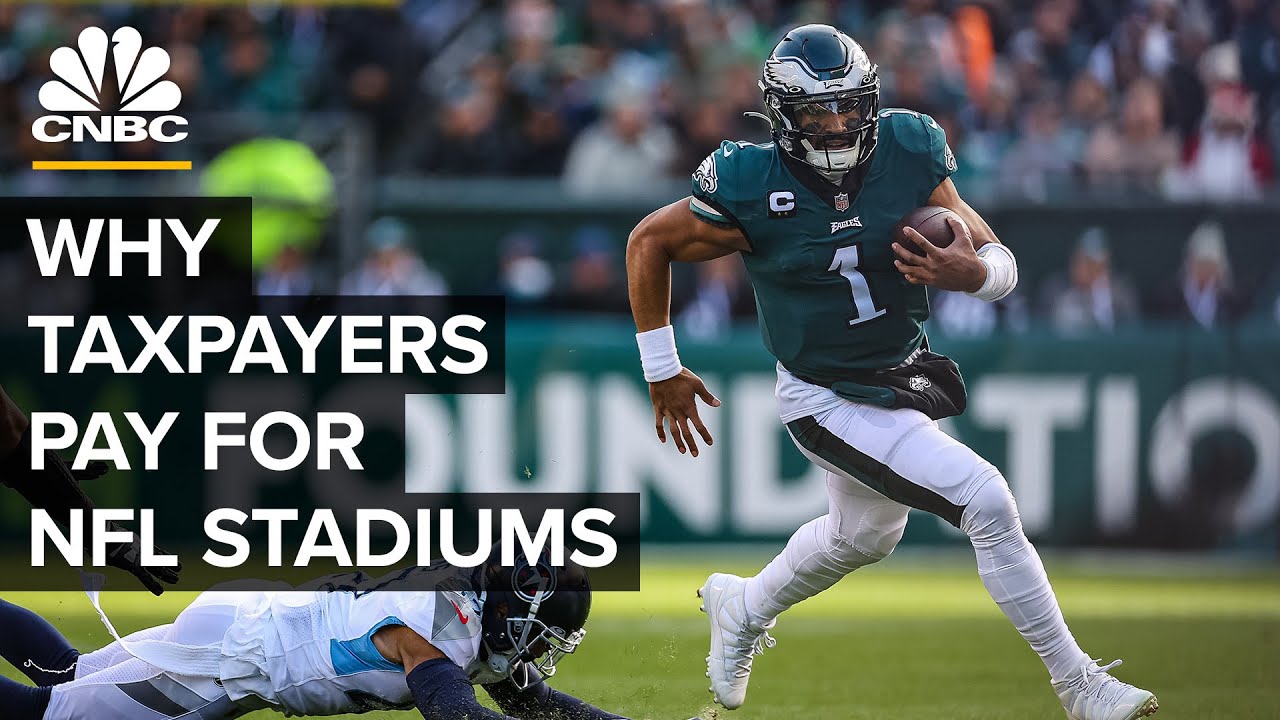1.7 million square feet,
a capacity about 60,000 Screaming fans. That's
the plan for the Tennessee Titans new
stadium in the heart of Nashville. It's
projected to cost $2.1 Billion. In more than
half will come directly From taxpayers. The over $1 billion
price tag is the most Public money ever
committed to an NFL Stadium beating out the
previous record of $850 Million set by New York
State in the Buffalo Bills just a year prior
since 2000. Subsidies for financing
major pro sports venues Have cost taxpayers an
estimated $4.3 billion, As 75% of new stadiums
built were backed by tax Exempt municipal bonds. And NFL stadiums are
some of the most Expensive facilities in
the world. It's also America's most
profitable league. The benefit is really for
the community and the Opportunity it provides
for locals. Being a major league
sports town may have Indirect linkages to an
economic and fiscal Benefit. While the NFL and team
owners estimate that Building stadiums will
provide economic growth For a city. Economists
and urban planners think Otherwise. We're talking about a ton
of money being used Usually across the
country. It doesn't go to a vote. It's it's really it's if
the mayor or the city Council wants to spend
these hundreds of Millions or potentially
even billions of dollars, We now have a lot of
empirical evidence, a lot
Of studies that show
that investing in Stadiums is not the best
idea. It doesn't give you the
best return on Investment. Lenders may perceive
bonds for a stadium as Pretty low risk because
the stadium is guaranteed To generate revenue. Because football is
cartel, it's not going to Go out of business
anytime soon. It all begins with the
issuing of tax exempt Bonds from state and
local governments that The federal government
has signed off on for Decades. These tax
exemptions help lower the Burden of high debt
through low interest Municipal bonds used by
cities and teams to pay For stadiums. Since
1913, municipal bonds Were a popular financing
option for things like Airports, roads,
hospitals and schools. Private entities had
access to public bonds, But were subject to a
volume cap that limits How much public bonds
are issued per year. As for stadiums, well,
they weren't subject to That cap. But fast
forward to the 1980s. We arrive at the Tax
Reform Act of 1986, the Bill one to end tax
exemptions for private Use, including stadiums. Instead, the bill
inadvertently created a Loophole allowing
stadiums to be backed by Tax free public bonds. So how does this
loophole even work? In order for stadiums to
be exempt from federal Taxation, they must fail
one of two tests. There's the private use
case test, which boils Down to no more than 10%
of the money from the
Bond is being used by a
private entity. Nfl teams will certainly
pass this, since pro Teams would use more
than 10% of that bond Money. Then there's the
private payment test, Also known as the 10%
loophole. That test states that no
more than 10% of the Bonds debt service is
backed by the stadium Itself. So if a state or
local government is Willing to finance at
least 90% of the stadium Bond, it fails the
private payment test, Meaning the stadium will
get tax exempt finance Through public bonds in
order to keep that tax Exemption. Repayment of
the bond cannot come Directly from revenues
generated from the Stadium or rent
collection. Instead, cities rely on
taxes like hotel taxes, To pay off these bonds
through tourism. Of course, that works
differently depending on How many tourists the
city attracts. Even how things are set
up varies from team to Team. Just take Las
Vegas in Chicago. The stadium authority
actually owns the Stadium. The benefit of
the stadium is actually To to the Raiders. We leased the stadium to
the Raiders for no cost. So the basic concept was
they're going to put a $1.25 billion into that
stadium and they are Going to get the direct
economic benefit of that Stadium. The public
through the room tax is Going to put in $750
Million. A lot of times the
argument is, well, you Also get exposure. You know, these Monday
Night Football shots Looking over Chicago
skyline will encourage
People to come and
visit. And there's really No way to to quantify if
that's actually Occurring. You can't go
out and ask everybody on The street who comes to
visit Chicago if they Came because they saw us
on Sunday Night football. The nineties became a
free for all for this Loophole and the moniker
of stadium mania was Created for this sports
era. Pro leagues and even
colleges began using Public funds for venues. The NFL saw major shake
ups in the nineties and Early aughts. New NFL
teams were added with Stadiums mostly paid for
by the public. Some teams moved to
cities completely Rebranding or rebooting
franchises. And as the dust settled
during the height of Stadium mania, the NFL
saw four teams move Cities for new teams
added to the league, all Of which were awarded
new, mostly publicly Funded stadiums. Stadium mania got so out
of control that bill was Introduced to Congress,
known as the Stadium Financing and Franchise
Relocation Act of 1999 to Combat teams leverage on
its home city. But that bill never came
to law. It's clear that stadiums
are largely paid for by Taxpayers and local
governments, and these Bonds can't be paid back
directly from what the Stadiums generate. So
the cities are left to Their own devices. And it may come as no
surprise that NFL teams Make hundreds of
millions of dollars in Revenue each year. The NFL's a privately
owned organization
Consisting of 32 teams. Revenues for each team
is split into two groups National and local
revenue. National revenue is the
money that the NFL Generates yearly from
things like media rights, Licensing, brand deals
and sponsorships. That money is split
evenly among all 32 Teams. Local revenue
varies from team to team, But it's the money that
the team generates from Ticket sales
concessions, licensing Team sponsorships and
even naming rights. One team, the Green Bay
Packers, is publicly Owned and provides some
insight to how the money Flows for the NFL. The Packers got $347
Million from the NFL for National Revenue in
2021. Multiply that by 32 Teams and you get $11.1
Billion for the entire League for local revenue
from things like ticket Sales, from hosting
620,000 fans and a stock Sale in 2021. The Packers made an
estimated $231.7 million In that year, though
there are over half a Million shareholders. Packers stock has no
monetary value. It doesn't pay
dividends, nor can be Sold. Yet $64.7 million
was generated by funding From newly deployed
stocks to fans. These stock sales
allowed the organization To reinvest in its
stadium. The Packers are Uniquely positioned
compared to the rest of The league. Since
they're a nonprofit Publicly owned team,
they can rely on things Like shareholder funding
to afford upgrades or Renovations at the
stadium might need.
As for the other 31
teams, they either rely On private funding or,
like most cases, public Funds. And in rare
cases, when a team in a City don't see eye to
eye, a team could just Move to a new city
willing to foot the bill. Hill is the chairman of
the Las Vegas Stadium Authority and was an
integral part of Facilitating the deal
that moved the Raiders From Oakland to Las
Vegas in the nearly $2 Billion Allegiant
Stadium. From our standpoint, I
think it's only leverage If you allow it to be
one of our principles Going into this is don't
fall in love with the Deal. It's got to work
for both sides. All deals should. And so from a leverage
standpoint, we Didn't really look at it
that way. We felt like we could
probably structure a deal That would work for the
Raiders in the NFL as Well as Las Vegas and
the state of Nevada. And we feel like we
certainly did that and Felt also that if we
couldn't do that, we Shouldn't move forward. It wouldn't ultimately
work for everybody Involved. Teams are valued anywhere
from 2.8 to $7.6 billion And bring at least $200
Million annually, which Begs the question why do
multibillion-dollar NFL Teams need public funds
for new stadiums? And do the home cities
reap any of the rewards? Spillover gains is the
idea that stadiums create An indirect, positive
economic impact. These gains are
difficult to track and Vary from city to city
and case by case.
In a comment to CNBC,
the NFL stated Private-public
partnerships had worked Well for decades as a
vehicle to build Multi-use community
stadiums. We understand that these
are difficult decisions For communities and
leaders and appreciate The support in the case
of Las Vegas. The government is better
positioned to recoup its Municipal bond
commitment as Las Vegas Is one of America's
biggest tourism hubs. We're collecting about 50
million additional Dollars through rent
taxes that's largely paid For by tourists, almost
completely paid for by Tourists. But the real
key there is the Stadium itself is
producing more tax Revenue than the 50
million just turned out To be, probably double
the 50 million. And that comes in the
form of live Entertainment tax, a
ticket tax, sales tax on Everything sold around
their modified business Tax, which is a payroll
tax. All of those types of
taxes then are into their Typical flow and used in
their typical way to Provide services
throughout Nevada. The spillover gains Hill
is referring to are Unique to not only just
the NFL, but all of pro Sports. Over 20 years of
research, studies have Found that stadiums are
costly and show little to No evidence that gains
outweigh the potential Tax burden for the city
and its people. You'll at least get the
new stadium and you'll Get like whatever other
economic activity spins Off the stadium. And then the stadium
pays for itself using
These sales taxes that
have come in otherwise. But that is only true if
you accept that the land That the stadium is on
and the borrowing Capacity used to raise
the money to build the Stadium. That if you
accept that, that could Not have been done for
any other possible land Use other than a
stadium. And that's just Clearly not true. Just take Chicago's
Soldier Field, for Example. In 2001,
Soldier Field needed Massive upgrades for its
aging stadium built in The 1920s. The beautiful old
stadium, just not Functional for the
modern NFL. The powers that be. Mayor Daly, who's big,
big idea guy, but also a Big deferred payment
sort of guy. Yeah, he signed us up
for 30 year bond Obligation and we
actually currently owe More than the original
project was estimated to Cost. Renovation costs were
$587 million $200 million In funding came directly
from the NFL and the Chicago Bears. The remaining 387
million was financed Through public municipal
bonds, all of which were Backed by increased
tourism taxes on Chicago's hotels. The city now owes $640
million on that initial $387 Million bond. But what about the money
generated by the team? Well, since funds
generated by the stadiums Can't be utilized to pay
back bonds, the local Revenue and NFL team
earns in a given season
Goes straight back to
the organization. Public funds diverted
into multibillion-dollar Teams make little sense
in the long run to a City. Yet cities
continue to shell out Hundreds of millions of
dollars for teams in 2021. Rumors spread that
the Buffalo Bills Threatened to move the
organization to Austin, Texas, if the team
didn't receive public Funding for a new
stadium. Well, the team Didn't move and it's
going to cost the city $850. Million in Public
Money was Diverted to Orchard Park Stadium in
New York. For perspective, Orchard
Park's per capita income Is $49,000 per year. Nashville, Tennessee has
received the most public Funding to date $1.26
billion of the estimated $2.1 Billion will come
directly from public Funding, and Nashville's
per capita income was Over $36,000 per year. The 10% loophole has
been widely criticized. The NFL, the most
profitable and popular Sports league in the US,
has garnered the most Attention. I think every city could
potentially brainstorm Other possible land uses
that can go on a space That are in demand and
that and that there's a Market for and that it
doesn't have to be Sports. Reducing or completely
eliminating the use of Public funds for
stadiums has become an Increasingly bipartisan
issue. Since 2015, both
Republicans and Democrats Have expressed their
shared interest in Closing the loophole.
In 2015, the Obama
administration proposed Removing the 10%
loophole for sports and Other private projects. In 2017, Democrat and
Republican Senators Cory Booker and James
Lankford introduced a Bill outlawing the use
of tax-exempt bonds for Any pro sports venues. That same year, the
Trump administration Proposed eliminating the
tax-exempt bonds for NFL Stadiums through the
administration's tax Reform bill. Most
recently, in 2022, Oregon Representative Earl
Blumenauer introduced a New bill called the No
Tax Subsidies for Stadiums Act of 2022. Yet no progress has been
made on that bill. I think this is something
that state and local Governments also need to
be taking a look at, Because especially for a
team that Serves multiple local
jurisdictions, the team Can, without leaving
their market and without Leaving their particular
region, they can still Try to pit local
jurisdictions against Each other in a bidding
war over the exact Location of a stadium
within a region. And that is really a
race to the bottom that Needs to stop. As for how fans feel
regarding this issue, Most just want to ensure
that their teams stay Put. Protests from fans
have erupted over the Years when other cities
have drawn their teams Away from them. Nfl
teams and their fan bases Are linked by a shared
identity, and a team can Reflect the city's
persona. Diehard fans From all 32 teams will
continue to fight hard to
Make sure that their
teams stay in their Hometowns, even if that
means they have to foot The bill.





